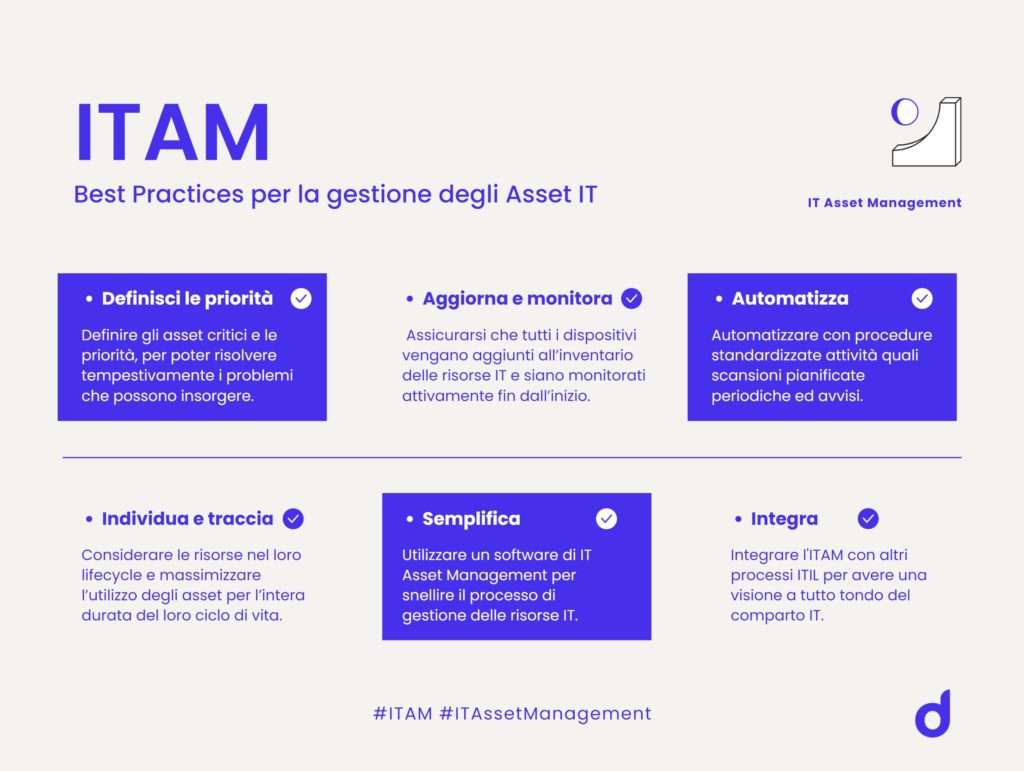Everything you need to know about Asset Management
How can we define IT Asset Management? What can ITAM do for your business? And what advantages can it bring? Let’s find out.
The correct definition of Asset Management
Let’s start from the basics and the correct definition of Asset Management, a concept widely used in various fields, such as finance and accounting. The words themselves lead us to its real meaning, namely that of resource management. In fact, Asset Management involves all company functions and all phases of their assets’ lifecycle.
IT Asset Management offers a strategic advantage and supports businesses in achieving their objectives.
A process therefore that has its own lifecycle that starts from the asset creation or acquisition and goes through phases, such as the monitoring of operation, maintenance interventions and the tracking of each update.
The ITAM thus allows not only to correctly manage the asset cycle but also to create value in strategic terms, as we will see better in the following paragraphs.
IT Asset and Lifecycle
We talked about asset management and specifically about IT assets but how can we exactly define an IT asset? What are those elements that with an ITAM tool are accounted for, tracked, updated and managed, in a strategic perspective of bringing added value?To make it easy, an IT asset is any important resource for the organizzation, from hardware, software systems, licenses or more generally data deemed important for the company. It is advisable to plan and manage in a strategic and proactive way all the specific phases of their lifecycle, since IT assets lose in performance over time.
Introducing an asset management solution: The advanteges
What are the advantages for a company in adopting an IT Asset Management tool?
A first advantage is a better organization and management at a general level and an efficient centralization of all resources that are in various devices and are used by different people. With an ITAM tool we therefore have a single source of data, or a single tool, for all asset information.
Greater order translates into better control of resources, reducing the risks associated with safety and preventing any regulatory sanctions. In fact, ITAM offers greater visibility on your IT assets, constantly monitoring their state of health and therefore being able to intervene promptly in case of need.
If we take an ITAM software, such as Deepser, it automatically detects all the resources, using different protocols, such as SNMP, WMI, SSH, Ping Sweep. For a company and specifically for its IT department, this means having the inventory of their devices constantly under control, and thus knowing every details of their infrastructure: from printers to switches, from the name of each resource to the BIOS version of PCs.
In this regard, the constant and orderly monitoring of assets helps not only to prevent but also to quickly resolve critical issues. Teams can move faster to identify critical assets and related vulnerabilities, promptly fixing them.
Constant monitoring also means cost reduction. Analyzing the actual use of the assets you can identify the exploited and the unused ones and save money. In fact, ITAM allows you to keep track of the relationships between company resources, plan maintenance activities and monitor the costs of each device.
If we add automation and standardized procedures, such as scans, controls, and automated alerts, we can easily understand how time and cost savings are substantial.

Best Practices for IT Asset Management
Let’s take a look at correct practices to be applied in the IT Asset Management process.
Here are some important guidelines to follow:
– define critical assets and priorities. Assigning the importance to IT resources means knowing how to prioritize the critical issues that impact on business activities, especially when problems involve more than one device at the same time.
– update and monitor IT resources frequently. Add all new devices to the inventory of IT resources and monitor them since the very beginning. You will have a complete and centralized overview of all assets and related reference data.
– use standardized processes and automate activities, such as periodic scheduled scans and automated alerts. These are useful to automatically track and assign incidents to related IT assets.
– identify and track data. Consider the resources in their lifecycle and act proactively tracking activities and maximizing the use of assets (request, procurement, distribution, maintenance and collection).
– simplify and streamline the IT resource management process effectively and achieve a more effective governance of the asset lifecycle.
– integrate the ITAM tool with other ITIL processes such as the construction of a complete CMDB to have a comprehensive view of the IT resources.
How to choose
IT management software allows for better management at software and hardware levels.
These platforms allow you to easily keep track of various data, such as asset maintenance, license compliance and budget used, thus keeping all information related to an asset stored and accessible in a single tool.
There are several products on the market, and during the software selection process it is essential to pay attention to specific characteristics.
A high quality software allows to keep track automatically of all networks and related data, from device interfaces to switches, from available IP addresses to all your subnets. That is an IP Address Management system that performs automated actions such as automatically detect all IPs, using different protocols, such as SNMP and WMI, quickly identify the Assets assigned to an IP, install an Agent or perform Agentless scans.
It is also important that the software we choose is natively integrated with other features used daily, such as CMDB, Password Manager and Help Desk.
With Deepser, for example, you will have a complete inventory of assets with automatic data discovery, manageable through a single, simple and intuitive web interface.
Activate now a free demo.